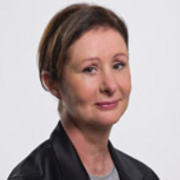
Ngila Dickson
Ngila Dickson's work on the Lord of the Rings trilogy involved designing and overseeing the making of thousands of costumes, from elven silk dresses to 15 copies of Gandalf's cloak. The result was eight awards, including Oscars and BAFTAs for best costume design (both shared with Richard Taylor). Dickson first honed her design skills on five feature films, and 100 plus episodes of Xena and Hercules.
Ngila — pronounced Nyla — Dickson began her love affair with clothing and design while growing up in Dunedin, where she regularly lapped up her mother's issues of French Vogue. After moving north to Auckland, Dickson began selling her own clothing designs at the Cook Street Market. Thanks to Rip it Up editor Murray Cammick, she soon got the chance to edit her own fashion magazine, ChaCha. She ran it for five years, until the magazine folded after the stock market crashed.
Dickson turned her hand to designing music videos, then began working in costume design on television and film. After costume designing mini-series The Rainbow Warrior Conspiracy in 1989, she made her feature debut on offbeat, visually-ambitious comedy User Friendly, directed by Gregor Nicholas. The film saw Dickson designing costumes for everybody from villainous doctors to a fornicating couple in over-the-top science fiction outfits, recreating the docking scene in 2001: A Space Odyssey.
More features followed, including dark tales Crush (which marked the feature debut of Alison Maclean) and Jack Be Nimble, before another big break: being shoulder-tapped by Peter Jackson to design the 50s-era costumes for Heavenly Creatures. Dickson sewed many of the costumes herself; she calls the film "a gift".
Dickson's next gigs offered a valuable opportunity to practice creating convincing costumes for imaginary, quasi-historical worlds: twin TV series Hercules: The Legendary Journeys and Xena: Warrior Princess (which she worked on until the end of the fourth season.) The fast turnaround demands of these locally-shot fantasy shows provided valuable experience for New Zealand film crews.
The shows' freewheeling styles saw Dickson designing costumes across a range of cultures and time periods, from Greece to revolutionary France, to Macedonia in the 1940s. Sometimes she found herself having to design and supervise construction of 100 costumes in just 10 days; there were also fruitful collaborations with Weta effects talent Richard Taylor, who created a number of monsters for the shows. Dickson was awarded design gongs at the 1997 and 1998 Film and TV Awards for her Xena contributions.
Dickson's work on the Lord of the Rings trilogy would dwarf even the manifold demands of Xena and Hercules. Aside from the 1000s of costumes that needed to be designed, sourced, dyed and aged, identical sets of costumes were required for stunt doubles, horse-riding doubles, and actors of completely different sizes. To help create the illusion that the hobbits were a different size than other races, costumes were recreated identically, in a larger scale weave. A single costume for one of the villainous Dark Riders required more than 50 metres worth of layered material.
Dickson began work on Lord of the Rings in April 1999, six months before shooting began, and set about assembling a 50 strong crew. Although the look of the films "had already been more or less established" by Richard Taylor's team of artists and effects wizards, there was no lack of things still to do. Dickson quickly found herself charged with establishing the look of the hobbits, dressing them in a "slightly off-kilter", late 17th/early 18th century look.
The hard work of Dickson, Richard Taylor and the Rings costume team resulted in more than 20 award nominations — including a BAFTA win for The Two Towers, and Oscars and American Costume Designers Guild gongs for The Return of the King. The 2004 Academy Awards ceremony proved especially memorable for Dickson; alongside winning for the last Rings film, she was nominated in the same category for Tom Cruise epic The Last Samurai, which saw her working with kimonos in Japan, Los Angeles and Taranaki.
Since leaving Middle Earth, Dickson has been in demand in other exotic locations. She has costume designed the South African-shot Blood Diamond, globetrotting thriller The International, and joined the Kiwi-heavy team on the Louisiana shoot for superhero movie Green Lantern. On the latter film she found herself for the first time working on a costume created entirely through CGI.
In 2012 Dickson was in charge of the costumes on Andrew Adamson's adaptation of Lloyd Jones Bougainville tale Mr Pip — a gig that would win her a Moa NZ Film Award for Best Costume Design — and the largely Kiwi-shot Emperor, set in Japan at the end of World War II. She designed costumes for the 2015 American mini-series adaptation of Arthur C Clarke classic Childhood's End (2015), and for Crouching Tiger, Hidden Dragon sequel Sword of Destiny.
In the 2004 Queens Birthday Honours, Dickson was awarded an ONZM "for services to design and the film industry".
Profile written by Ian Pryor
Sources include
'Costume Designer - Ngila Dickson (Lord of the Rings)' (Interview - broken link). M2E Productions website. Accessed 4 April 2013
'Ngila Dickson - Costume Designer' The Arts Foundation website. Accessed 2 October 2016
Brian Sibley, The Lord of the Rings - The Making of the Movie Trilogy (London: HarperCollinsPublishers, 2002)
Robert Weisbrot, Xena Warrior Princess - The Official Guide to the Xenaverse (New York: Doubleday, 1998)